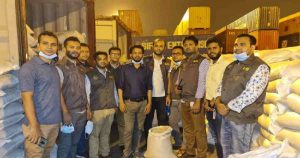August 27, 2018, SANDRP – Accepting that reservoirs operation and flood management in India lack scientific supports, Madhavan Nair Rajeevan, Secretary, Ministry of Earth Sciences, in an interview has revealed that dams and water reservoirs need flood management systems that use scientific methods to understand when the time is right to open the gates.
“As per my understanding, no big reservoir has a decision support system. So we don’t know when to open them, how to open them… I am not attributing the Kerala floods to an individual.
There is a common perception that in India most of the flood management systems are not supported by science… I am very sure we don’t have the decision support system and we need it.” https://indianexpress.com/article/india/not-just-kerala-no-scientific-dam-water-management-across-india-madhavan-nair-rajeevan-secy-earth-sciences-5322003/ (24 Aug. 2018)
In another interview, he says that while Kerala records among the highest amounts of rainfall in the country, the State did not have a flood warning system in place. He added that while there were several sophisticated tools to anticipate extreme weather events, India still lacked a mechanism to effectively deploy them. https://www.thehindu.com/sci-tech/energy-and-environment/reservoirs-not-managed-using-a-scientific-decision-support-system-m-rajeevan/article24785253.ece (26 Aug. 2018)
Further, in a detailed interview, he pitches for ‘decision support systems’ at dams, acknowledges the challenge of climate change, warn against repercussions of ‘fast-warming’ Indian Ocean.
https://indianexpress.com/article/india/kerala-floods-m-rajeevan-ministry-of-earth-sciences-met-department-5324840/ (26 Aug. 2018)
More experts are corroborating what SANDRP have said from the beginning about the role of dams in Kerala’s floods.
– “Yes, the rainfall was extremely heavy; much more than Kerala receives at this time of the year. However, the IMD (Indian Meteorological Department) had predicted that the extremely heavy rainfall was very likely and the state should have taken the decision to release water from the dams that were almost full when the rains had subsided in July,” said an IMD official on condition of anonymity.
– “The flood damages could have been reduced by 20-40% had the dams and reservoirs released the water slowly in the two week period when the rains had subsided. The state did not have an advanced warning system in place and released water from the dams only once the danger levels (levels at which the dams structures can be damaged) were reached,” said Delhi’s Indian Institute of Technology civil engineering professor Ashok Keshari.
https://www.hindustantimes.com/india-news/early-release-of-dam-water-could-have-reduced-kerala-flood-damages-say-experts/story-iknyHxWN1l51nuXPFAUSBJ.html (21 Aug. 2018)
• If extreme weather events are increasing under different climate change scenarios and there is not much that we can do to mitigate climate change, we certainly need to prepare ourselves to reduce the risk from such occurrences.
• The first and foremost step is to have a robust forecasting and prediction system.
• India has one of the best weather forecasting systems and some of the weather-related observatories are located on the Kerala coast, where the southwest monsoon makes its entry in June every year.
• The country has world-class remote sensing and weather and earth observation satellites that keep an eye on the Indian landmass.
• In addition, we have access to imagery from other agencies like NASA. Weather forecast and satellite data need to be used in synergy with ground data from reservoirs and dams to issue flood forecast and warnings.
• Then these warnings have to be conveyed to people and evacuation, if necessary, needs to follow.
• In this exercise, multiple agencies at central and state levels — scientific, technical, administration, government departments — are involved.
• Coordination and action is required in real time. This is where we are lacking.
For instance, the CWC — which is in-charge of flood forecasting — has no ground stations in Kerala for this purpose. In addition, as Himanshu Thakkar of SANDRP has pointed out, the magnitude of the disaster in Kerala could have been minimised “if dam operators had started releasing water in advance rather than waiting for dams to be filled up, when they have no alternative but to release water”.
If we are serious about tackling floods —annual floods in Assam, Odisha as well as floods triggered by extreme rainfall in other — we need an agency exclusively for this purpose. Such an agency should collect and analyses all hydrological data — rivers, dams, rainfall, glacier melt etc — and coordinate with other agencies like IMD and ISRO as well as the NDMA. All such information and data should be made publicly available. CWC has too many things on its plate and can’t effectively act as a flood forecasting agency. https://www.dailyo.in/variety/kerala-floods-central-water-commission-not-time-for-blame-game-but-why-dont-we-have-any-emergency-plan/story/1/26182.html (21 Aug. 2018)
Indeed, the Kerala flood has highlighted our poor dam management system: In India’s quest to control water, dams have always loomed large. But for dams to truly tame floods, experts say dam reservoirs need to be relatively empty before the onset of rains.
Back in 1924, a combination of heavy rain and a breached dam triggered deadly floods that claimed 1,000 lives. In 2018, history may have repeated itself. Under relentless downpours, poor dam management may have aggravated the floods, raising questions about the role of dams in Kerala and other states.
– According to Himanshu Thakkar, coordinator of the SANDRP, this was not the case in Kerala.
The Idukki dam was already near full capacity by July-end even as rains were relatively weak (below normal levels) during that period.
– When the downpours arrived in August, the near full-capacity Idukki was forced to release water into already flooded areas. Thakkar believes this lack of foresight is common in India’s dam management and has worsened floods across the country. “Filling up the reservoirs before the end of the monsoon is an invitation to disaster,” he said over the phone, adding that “while dams can help control floods, they need to be managed properly”.
https://www.livemint.com/Politics/oSkzuw37GHm9u0UvbD0C5H/Kerala-floods-highlight-Indias-poor-dam-management.html (21 Aug. 2018)
Another report quoting Himanshu Thakkar, coordinator of the SANDRP writes that dams should not be filled up before the monsoon. Idukki dam was already filled in July. When Idukki was full they thought of releasing the water but didn’t release. They released after another calamity.
CWC, India’s only flood forecasting agency, has no site in Kerala. You don’t have any way to guide you on what is coming. There was huge potential to reduce disaster impact if dams were not full. Mullaperiyar dam should not have been filled before the end of monsoon.
https://economictimes.indiatimes.com/markets/stocks/news/sos-from-kerala-on-disaster-management/articleshow/65469269.cms (20 Aug. 2018)




